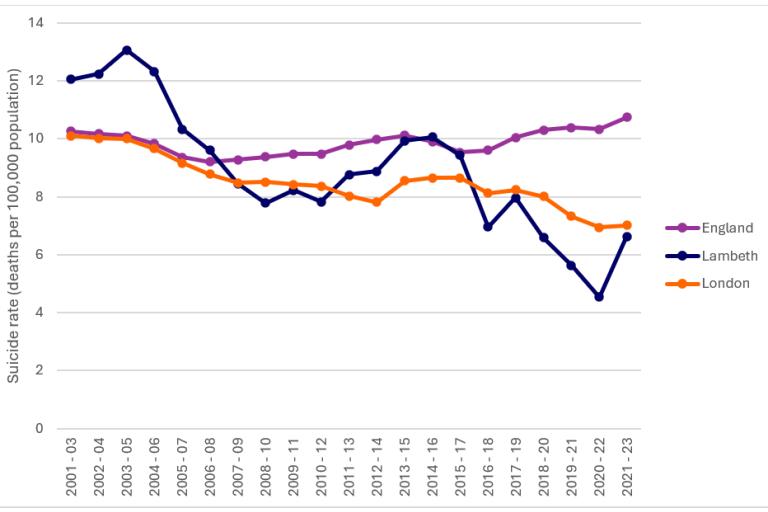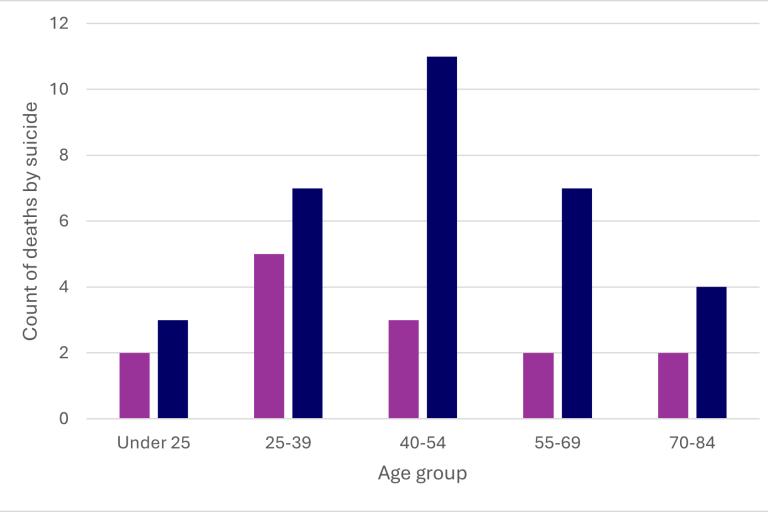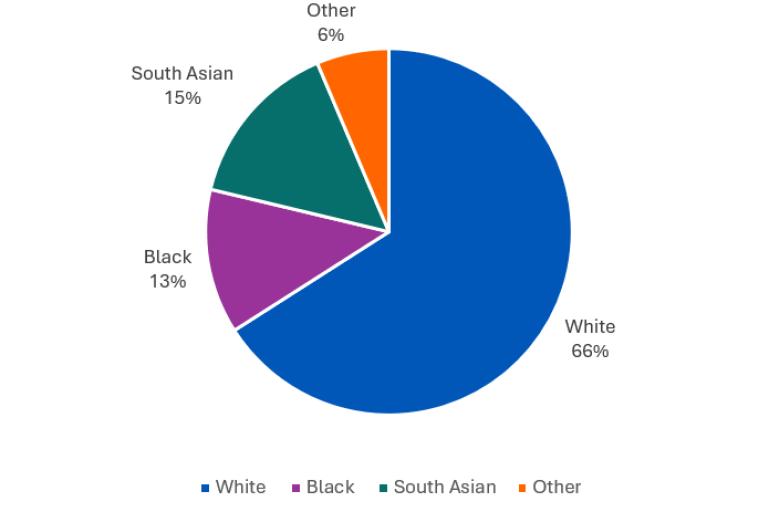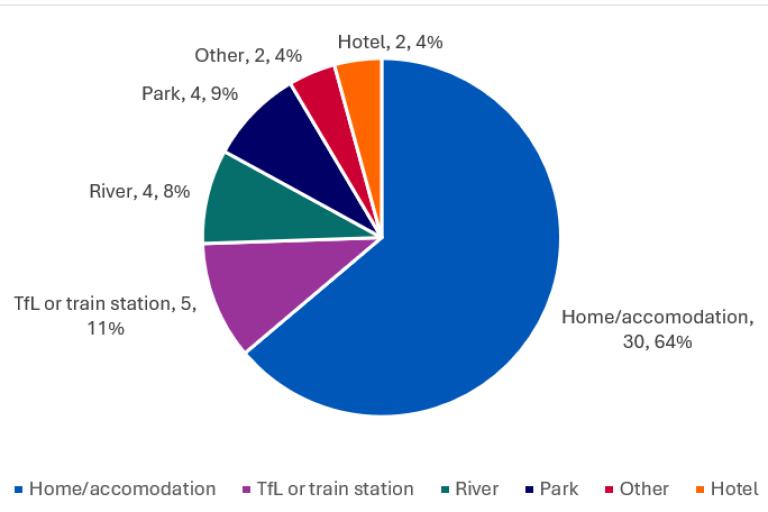Understanding suicide in Lambeth
Every year, around 15 people living in Lambeth will die from suicide. There is also a significant number of suicide deaths that occur within the borough of people who are resident in other local authority areas. An essential part of effective suicide prevention is understanding who is dying from suicide, where they died, what methods they used and what risk factors might have contributed to the suicide.
We have collated data from open sources and data available to the Lambeth Public Health Intelligence Team. This includes data from the Office for National Statistics (ONS) on suicides in England and Thrive LDN’s Real Time Surveillance System (RTSS). It should be noted that the Thrive dataset includes suspected (not confirmed) suicides in London, and it does not contain suicides which occur in mental health facilities or prisons (prior to 2024). There is also currently a delay in addressing backlogs in the RTSS, meaning data for 2024 is currently incomplete (and therefore has been excluded from this document). There are some discrepancies in the count data from Thrive LDN and the ONS. Due to a lack of data from primary care and detailed coroner data, there are some gaps in our understanding. The text below summarises key points from data analysed to date.
Key Statistics
Lambeth has a lower suicide rate than London and its statistical neighbours however this is not a statistically significant difference.
Suicide rates vary significantly between the regions and countries of the UK. England has the lowest suicide rate, followed by Northern Island, Wales, and Scotland. Across England, suicide rates range from 13.8 deaths per 100,000 population in the North East to 7 deaths per 100,000 population in London. The suicide rate in Lambeth between 2021-2023 was 6.6 deaths per 100,000 population. There are no significant differences between the suicide rate in Lambeth and the rates in its statistical neighbours.
The suicide rate in Lambeth and London has plateaued over the last 10 years
There has been a general decrease in suicide rates in Lambeth and London since 2001. However, rates have plateaued over the last 10 years and have actually been increasing for England overall. The England and Wales suicide rate in 2023 (11.4 deaths per 100,000 people) was the highest observed since 1999. The suicide rate in Lambeth follows a similar trend to London, which has been lower than the overall rate for England for the last 20 years.

Figure 1 3-year average suicide rate in England, London and Lambeth since 2001 (source: Office for Health Improvement and Disparities, public health profiles, https://fingertips.phe.org.uk/.)
Almost two thirds of suicides in Lambeth occurred among males
Over the three-year period between 2021-2023, there were 49 suicides in Lambeth. The majority (62%) of these deaths were male. In England, suicide is the leading cause of death among men aged 20 to 34 years.
Between 2021 to 2023, 38% of all suicides in Lambeth were men aged 40 to 69 years (Thrive LDN dataset). For females, there was a more equal spread of suicide deaths across age groups in Lambeth.

Figure 2 Number of deaths by suicide in Lambeth between 2021 to 2023 by age group and gender (source: Thrive LDN dataset). Note that groups with a count of 1 have been excluded.
Suicide rates are higher among more deprived groups in England
Analysis of suicide rates by Index of Multiple Deprivation (IMD) decile band shows that there is a far larger burden of suicide deaths in the five most deprived deciles compared to the five least deprived.
The life expectancy gained if the most deprived quintile in Lambeth had the same mortality from suicide as the least deprived quintile would be 0.14 years in males, and 0.02 years in females (PHE 2015).
The majority of suicides in Lambeth occurred among people of white ethnicity
Of the 49 suicide deaths in Lambeth between 2021 to 2023, 66% were people of white ethnicity, 13% were of Black ethnicity and 15% South Asian13 (see figure 3). In comparison, people of white ethnicity make up 59% of the population, while 23% are Black and 3% are South Asian. However, as these figures are very small it is difficult to draw firm conclusions around the relationship between ethnicity and suicide in Lambeth.

Figure 3 Suicide deaths in Lambeth between 2021 to 2023 by ethnicity. Source: Thrive LDN dataset.
Residential premises was the most common location of suicide deaths in Lambeth
Between 2021 to 2023, 64% of suicide deaths occurred in residential premises according to Thrive LDN RTSS data. Of known non-residential locations, the most common were train or TfL stations, river and parks (see figure 4).

Figure 4 Suicide deaths in Lambeth from 2021 to 2023 by location of death (Figure and percentage). Source: Thrive LDN dataset.
Groups at high risk of suicide
There are some groups that are at higher risk of suicide and could particularly benefit from targeted action. The Suicide Prevention Strategy for England: 2023 to 2028 identifies seven priority groups. We have also identified additional groups relevant to Lambeth. These are described below.
Groups from the National Suicide Prevention Strategy:
Children and young people
While the suicide rate in under-20s is relatively low compared to older age groups, rates across all age groups under 25 have been increasing over the last decade in England. This increase is particularly apparent among females under 25.
In Lambeth, 11% suicide deaths occurred in under 25s between 2021 to 2023 (source: Thrive LDN RTSS dataset). Lambeth has a young population relative to England and we know that there is a high prevalence of mental health issues among young people in the borough. A recent study of 4,300 11- to 14-year-olds in Lambeth and Southwark showed that 19% of adolescents had mental health problems, 15% had depression, 14% had anxiety and 15% had self-harmed at some point in their lifetime. This equates to about one in five adolescents having a mental health problem compared to around one in seven to eight nationally. While the incidence of suicide among young people in Lambeth is low, data suggests there is a relatively high prevalence of self-harm. Self-harm is the most important risk factor for suicide, so is a key focus for the strategy.
Students in higher education are an important group for suicide prevention due to the unique challenges and stresses associated with the transition into higher education. Lambeth has a considerable student population with several university and college campus sites within or near the borough. As at 2021/22, there were almost 5,000 student accommodation spaces across 14 locations in Lambeth.
Middle-aged men
Men in England are three times more likely to die by suicide than women, with middle-aged men having the highest rates of suicide of any other group.
In Lambeth, men aged 45 to 64 years have the highest levels of death by suicide across all age and gender groups.
People in contact with mental health services
Evidence suggests that people with a mental health condition have a nearly eight-fold increased risk of suicide. Around 27% of suicide deaths in England were people known to mental health services.
An estimated 1.3% of GP patients registered in Lambeth (or 5,557 people) are registered as having schizophrenia, bipolar affective disorder and other psychoses. The premature mortality rate for people with severe mental illness in Lambeth is 136 per 100,000 population compared to 111 per 100,000 for England, however this is not solely due to suicide.
There are currently gaps in suicide data in Lambeth; however, based on available information, there are very few people in Lambeth who die by suicide who were previously in contact with secondary mental healthcare services.
People in contact with the justice system
People in contact with the justice system have higher rates of suicide and self-harm behaviour than the general population. The risk of male prisoners dying by suicide was almost four times higher than the general male population between 2008 and 2019.
HMP Brixton in Lambeth has a total prison population of 658 as of June 2021. The rate of children (10-17 years) entering the youth justice system in Lambeth was 4.4 per 1,000 population compared to 1.1 per 1,000 in England overall. Information on the rate of adults entering the criminal justice system in Lambeth is not currently available.
People with autism
There is evidence to suggest that suicide risk is higher among people with autism compared to the general population. As of April 2024, there were over 4,000 people in Lambeth diagnosed with Autism Spectrum Disorder (ASD).
Pregnant women and new mothers
In the UK, suicide is the leading cause of direct deaths 6 weeks to a year after the end of pregnancy. Overall, the level of risk of suicide after pregnancy is not higher than at other times in a woman’s life. However, the high risk compared with other causes of maternal death (most of which are rare) and the potential long-term consequences on children’s development mean pregnant women and new mothers is a priority group for action.
Based on a public mental health needs assessment for children and young people in Lambeth, there are an estimated 8,298 mothers in Lambeth with a mental disorder and between 998 to 1,639 women with a mental disorder during the perinatal period. (Campion J (2022) Public Mental Health Needs Assessment For Children And Young People In Lambeth).
Other groups identified from the evidence base and Lambeth priorities:
People who have self-harmed
Self-harm is the strongest risk factor for subsequent suicide. Evidence suggests that one in 25 patients presenting to hospital for self-harm will die by suicide in the next 5 years.
In 2022/23 there were 150 emergency hospital admissions for self-harm in Lambeth, among the lowest in England. The number of emergency admissions for self-harm is much larger than suicide counts each year. However, those admitted for self-harm represent only a proportion of those who self-harm as many people do not present to hospital after a self-harm episode.
The rate of hospital admissions for all ages for self-harm in Lambeth is 44.9 per 100,000, compared to 126.3 per 100,000 for England. However, there is variation across age groups. Among under 25s in Lambeth, 15- to 19-year-olds have the highest rate of admissions for self-harm at 261.1 per 100,000 in 2022/23.
There is also variation across genders. Females have a higher rate of hospital admission for self-harm, the opposite trend observed in suicide deaths. In 2022/23, the self-harm admission rate for females in Lambeth was 57.4 per 100,000 compared to 32.5 per 100,000 in males. This difference is particularly stark among teenagers, with 35 of the 40 hospital admissions for self-harm among 15 to19 year olds in Lambeth being females (a rate of 457.3 per 100,000).
Carers
Carers are more likely to experience risk factors for suicide such as social isolation and financial difficulties. There is emerging evidence to suggest that carers are a high-risk group for suicide.
In Lambeth there were 1,065 carers in contact with services and receiving carer support in 2020-21. However, the 2020/21 Family Resources Survey estimated that around 6% of the population provide informal care to someone, meaning there are around 20,000 informal carers in Lambeth.
LGBTQ+ communities
LGBTQ+ people are more at risk of suicidal behaviour and self-harm. The higher rates of mental health issues among LGBTQ+ groups may be related to experiences such as stigma, prejudice, and discrimination.
It is estimated that Lambeth has more LGBTQ+ people living within its borders than any other London borough. Since 2017, Lambeth Council has been working on a whole system approach to help improve how the services LGBTQ+ people access in the borough.
People with disabilities
Disabled people have much higher rates of suicide compared with non-disabled people in England. For both men and women, the suicide rate among disabled people is around three times the rate among non-disabled people.
There are an estimated 46,500 people living with a disability or impairment in Lambeth.
Asylum Seekers
Evidence suggests that asylum seekers have higher rates of mental health conditions, putting them at higher risk of suicide and self-harm.
Black, Asian and Multi ethnic groups
Lambeth is an ethnically diverse population with residents from a wide range of ethnicities and backgrounds. People of Black, Asian and Multi ethnicities account for around 40% of the total population. We know that some Black, Asian, and multi ethnic groups have a higher prevalence of suicide risk factors such as deprivation and low income, poor physical health and severe mental illness. There is also some emerging local data which suggests those from a South Asian background may be more at risk. However, further investigation will be needed in order to list Black, Asian and Multi ethnic groups has been at higher risk of suicide.
It should also be noted that there is significant overlap between the suicide risk factors listed above and the risk factors which impact on mental health and wellbeing. We acknowledge that there are known racial inequalities in Lambeth which impact on mental health and wellbeing. These will be described and addressed in further detail through the wider Public Mental Health work in Lambeth.
Suicide risk factors
Addressing suicide risk factors is a key component of suicide prevention. The national strategy has identified six priority risk factors. These are described below along with other risk factors which are important for suicide prevention in Lambeth.
Risk factors included in the Suicide Prevention Strategy for England 2023-2028:
Physical illness
Evidence suggests that a diagnosis of a severe physical health condition may be linked to higher suicide rates. Data from 2017 showed that over half (52%) of men who died by suicide had a physical health condition, most commonly circulatory system diseases like hypertension.
Financial difficulty and economic adversity
Financial problems can lead to suicidal thoughts and increased risk of suicide. There is evidence to show that suicide rates increase during periods of economic recession. The current cost living crisis in the UK has increased the number of people facing economic adversity.
Harmful gambling
Evidence suggests that deaths from suicide were significantly higher among adults with gambling disorder or problems compared to the general adult population. People with gambling problems are estimated to have over double the odds of suicide compared to the general population. Approximately 3.8% of the UK population are classified as gambling at elevated risks and so might experience some level of negative consequences due to their gambling.
There are likely inequalities in the prevalence of gambling problems. People living in more deprived areas, Black, Asian, and multi ethnic groups and younger people are more likely to live near betting shops.
Substance misuse
Consistent links have been evidenced between alcohol and drug use and suicide. Acute intoxication, as well as dependence on alcohol and/or drugs, has been associated with a substantial increase in the risk of suicide and self-harm.
We know that there is a higher-than-average prevalence of substance misuse in Lambeth. An estimated 12.3 people per 1,000 population use opiates and/or crack cocaine, compared to an average of 8.9 per 1,000 for England.
Social isolation and loneliness
Evidence suggests that there is a greater risk of suicide among people who are lonely. This risk factor is of particular importance for young people. Additionally, loneliness among older people is recognised as a societal issue and 1.4 million older people in the UK are often lonely.
In Lambeth almost 24% of adults reported feeling lonely often, always or some of the time. Almost 40% of Lambeth’s population aged over 65 live alone, which is a higher proportion than London or England.
Domestic abuse
Domestic abuse is a major risk factor for suicide. Women are more likely than men to experience domestic abuse. Studies have estimated the lifetime prevalence of intimate partner violence for women was 37%.
Levels of domestic abuse crimes in Lambeth are slightly higher than the England average. In 2022/23 there 34.5 domestic abuse incidents and crimes per 1,000 population compared to 30.6 per 1,000 for England overall.
Other risk factors from the evidence base:
Deprivation
People living in the most deprived areas of England have almost double the risk of suicide than those living in the least deprived areas. The suicide rate in the most deprived decile in 2017-2019 was 14.1 per 100,000 compared to a rate of 7.4 in the least deprived decile. Analysis by the ONS showed that suicide rates were highest for people who had never worked or were unemployed.
Deprivation is high in Lambeth. Seventy percent of the Lambeth population lives in the 40% most deprived areas in England. Fifteen percent of the population in Lambeth is income deprived.
Suicide bereavement
The suicide of a relative triples an individual's odds of suicide or suicide attempt, and the suicide of a friend or acquaintance increases these odds by a factor of 2·5. It is estimated that up to 135 people are affected by a suicide death, meaning there is likely to be a considerable number of people with increased risk of suicide due to suicide bereavement. Effective prevention measures for people bereaved by suicide are essential in order to minimise their risk of suicide.
Homelessness
Suicide was a leading cause of death among homeless people, accounting for 13% of deaths in 2021 but this is likely to be an underestimate. Lambeth has the fourth-highest number of homeless people across London boroughs, with an estimated 681 people sleeping rough according to data from 2023/24.
Climate change / extreme heat
Emerging evidence suggests that extreme heat is associated with worsening mental health outcomes, including suicide and suicidal behaviours. This is of particular concern as we are seeing increasing temperatures and heatwaves in London related to climate change.
